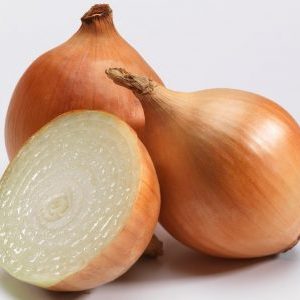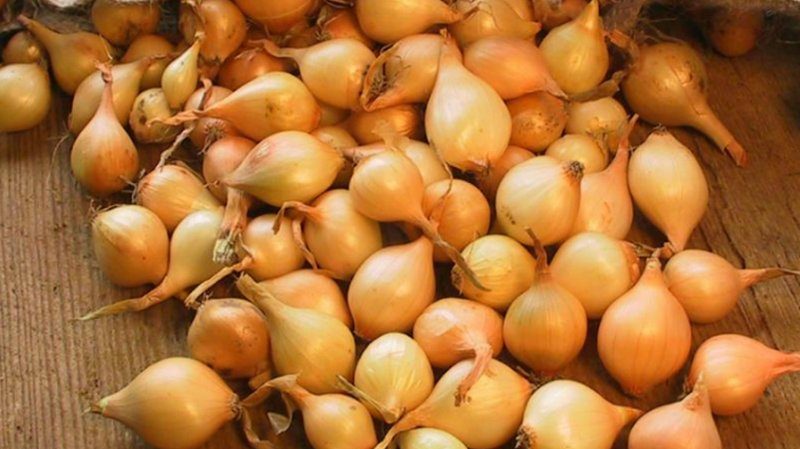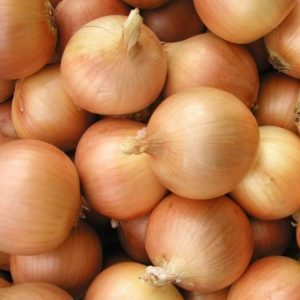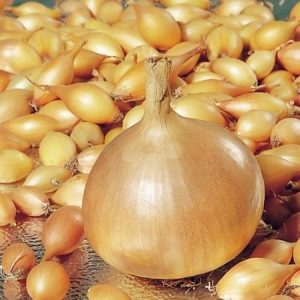Early high-yielding hybrid of Cupido onions for greenhouse and outdoor cultivation
Gardeners increasingly prefer to plant Dutch-bred onions in plots, as they are more hardy, unpretentious and have a pleasant taste. Cupido is one of the popular onion hybrids suitable for private plots and large farms.
The content of the article
Description of the hybrid
Cupido F1 is a heterotic (with accelerated growth and increased viability) hybrid of the first generation.
Its bulbs are used universally: consumed fresh, added to salads and preparations, used for cooking, stewing and frying.
Origin and development
Cupido F1 hybrid onion bred by Dutch breeders, originator - NICKERSON ZWAAN B.V.
The hybrid was included in the State Register of Russia in 2015.
Chemical composition, trace elements, vitamins and beneficial properties
Cupido contains:
- essential oil;
- proteins;
- carbohydrates;
- Sahara;
- mineral salts;
- vitamins of group B, C, PP;
- macro- and microelements.
Onion stimulates immunity and metabolism, protects the body from viruses, has an antibacterial effect, acts as a source of essential vitamins and minerals, and helps to remove toxins from the body.
Ripening period and yield
This is a medium-early ripening onion - the harvest is harvested 75-85 days after germination.
Marketable yield - 266-355 c / ha.
Reference. The maximum yield was recorded in the Moscow region - 604 c / ha.
Disease resistance
With proper planting care, Cupido is not prone to disease. Among pests, onion flies are the most dangerous for this onion.
Characteristics of the bulb, description of the appearance, taste
The hybrid forms dense two-bud bulbs with a neck of medium thickness, which are round in shape and weigh 90-120 g.
The heads are covered with brownish-yellow husk, the flesh is white with a greenish tint. The taste is soft, semi-sharp.
For which regions it is best suited and what is the exacting climate
The hybrid is included in the State Register for the Central, Central Black Earth, Lower Volga and Far Eastern regions.
Reference. When cultivated in areas located north of the middle zone of the European part of Russia, onions need protection from frost.
The main advantages and disadvantages of a hybrid
Pros:
- high productivity;
- early maturation;
- pleasant taste;
- resistance to shooting, drought, insects and diseases;
- possibility of long storage;
- unpretentiousness;
- high commercial qualities and transportability.
Minuses:
- low resistance to frost;
- sensitivity to sudden changes in temperature in spring;
- impossibility of self-procurement of seeds.
What is the difference from others
Comparison of Cupido with other hybrids is presented in the table.
| Hybrid | Ripening period | Productivity, c / ha | Bulb shape | Bulb weight, g | Taste |
| Cupid | Mid-early | 266-355 | Rounded | 90-120 | Semi-sharp |
| Lamika | Mid-season | 302-341 | Broadly ovate | 90-100 | Semi-sharp |
| Legend | Mid-season | 377-593 | Wide elliptical | 90-105 | Acute |
Features of planting and growing
Cupido onion is a biennial plant. First, a set is grown from seeds, which in the second year is used to obtain large turnips.
The hybrid can be grown outdoors and greenhouses, it is suitable for spring and winter landing.
Preparing for landing
First of all, it is important to choose the right planting material: the seeds should be last year's, and the seeds should be dry, dense, without traces of mold, rot and an unpleasant odor. The optimal bulb size is 1-1.5 cm. Specimens with a diameter exceeding 1.5 cm are prone to shooting, and bulbs that are too small are inconvenient to plant.
Before sowing, the quality of the seeds is checked by immersing them in a saline solution: empty grains float up, and full grains sink. After that, the seeds are soaked in a solution of potassium permanganate for disinfection and dried well.
Important! Seeds purchased from specialized stores do not require additional processing.
Before planting, Cupido onions are dried and heated at a temperature of + 30 ... + 35 ° C for 7-14 days, then treated with a solution of potassium permanganate or copper sulfate for disinfection and growth stimulants.
The site is cleared of weeds, plant residues in advance, organic fertilizers are dug up and applied to the ground - compost, humus or rotted chicken droppings.
Ground requirements
The hybrid prefers loose, nutritious, fertile soil with good moisture permeability, aeration and a neutral or slightly alkaline reaction (pH 6.6-7.4). The best option is sandstone and loam.
Timing, scheme and landing rules
Seed sowing scheme for seedlings:
- Pour nutritious soil mixture into the prepared container and water it abundantly.
- After absorbing water, make grooves no more than 1.5 cm deep in the soil every 5 cm.
- Spread the seeds along the length of the furrows and cover them with soil.
- Cover the container with polyethylene and put it in a bright place at a temperature of + 20 ... + 22 ° C until shoots appear.
- Remove polyethylene after sprouting onions.
In the case of sowing seeds in open ground, the scheme remains the same, and the distance between the rows should be sufficient for weeding and loosening.
The timing of transplanting seedlings into open ground depends on climatic conditions: the main thing is that the soil warms up, the weather is stable and there is no threat of frost.
Transplanting seedlings:
- Prepare the beds at a distance of 20 cm from each other.
- Make holes in them 5-6 cm deep every 10 cm.
- Pour 0.5 liters of warm water into each well, to which you can add growth stimulants.
- When the water is absorbed, place the plants removed from the container with a lump of earth into the holes.
- Pour earth into the holes, tamp it.
- If desired, mulch the beds.
Sevok is planted in the ground in the fall (3-4 weeks before frost) or in spring, after establishing stable warm weather, according to the following scheme:
- Prepare the beds on the site, considering that the distance between them should be at least 20 cm.
- Make grooves in the beds for planting onions every 10 cm.
- Place the onions in them, deepening 3-5 cm for spring planting and 10 cm for autumn planting.
- Cover the sevok with earth, leaving the tails on the surface.
- Mulch the beds with straw or peat in case of winter planting.
Growing features

Cupido's landing site should be open to sunlight, but protected from the wind.
The best predecessors for this hybrid are cucumbers, zucchini, squash, chili peppers, tomatoes, potatoes, cabbage, spinach, radish, salads.
You should not plant onions after dill, parsnips, celery, peas, beans, turnips, radishes.
The nuances of care
Competent care is the key to a plentiful and high-quality harvest. Therefore, it is important to know about the nuances of watering, loosening the soil and applying fertilizers.
Watering mode
Cupido grows well in moderately moist soil and tolerates drought better than excessive watering, therefore, when irrigating, they are guided by the state of the upper soil layer. In a moderately dry summer, watering is carried out once every 2-3 weeks.
Watering is stopped 3-4 weeks before harvesting - this helps to improve the taste of the bulbs and increase their shelf life.
Loosening the soil and weeding
After each watering, but at least once a week, the soil between the rows is loosened to a depth of 4-6 cm. This procedure improves the access of moisture and air to the underground part of the plants and helps to get rid of weeds that hinder the growth and development of onions.
Reference. When loosening, the noses of the sets must not be allowed to be covered with earth, otherwise the onion will stop growing.
Top dressing
If the hybrid is planted in fertile soil, then the fertilizer applied before planting is sufficient.
Otherwise, during the growing season, fertilizing is applied twice:
- at the end of May - ammonium nitrate (10-15 g per 1 m²);
- in the second decade of June - potassium salt (10-15 g per 1 m²).
The beds must be watered before fertilizing.
Disease and pest control
Subject to agrotechnical requirements, Cupido maintains resistance to diseases. However, plants can be attacked pests, in particular, onion flies.
To prevent insect attacks, the beds are mulched with peat, the soil and plants are powdered with wood ash or tobacco. If the parasites have already hit the planting, they are treated with insecticides, for example, "Mukhoedom" or "Alatar".
Harvesting and storage
The harvest of Cupido onions is stored for a long time, but for this the bulbs need to be properly collected, prepared and provided with optimal storage conditions.
How and when to collect
When planted in autumn, onions ripen in May, and when planted in spring, in August. Drying and lodging of feathers serves as a signal of the readiness of the crop for harvesting.
The bulbs are carefully dug in with a shovel or a special bracket and removed from the ground.
Storage features and keeping quality of the hybrid

The dug out bulbs are examined and sorted out, discarded or set aside for early use spoiled or damaged specimens.
After that, the onions are left in a dry and well-ventilated place to dry for 5-7 days. Then they knead, separate the dry tops from the turnips and send the bulbs for a week for repeated drying at a temperature of at least + 30 ... + 35 ° C.
Prepared bulbs are placed in baskets or wooden boxes and placed in a dark room with moderate humidity and an air temperature of + 5 ... + 7 ° C. In such conditions, the harvest is stored for about 9 months.
What can be the difficulties in growing
When growing Cupido onions, some problems can arise:
- shooting - the hybrid releases arrows if it freezes, in case of sudden temperature changes or when planting too large a seed;
- the development of fungal and other diseases in case of improper care, in particular - excessive watering;
- the death of plants due to untimely fertilization, for example, at the stage of growing seedlings.
Tips from experienced gardeners
Experienced farmers recommend:
- Plant carrots, marigolds or calendula next to onion beds - these plants scare off onion flies.
- When the feathers begin to dry out, slightly open the onion bushes and pull them up, tearing off some of the roots - this has a positive effect on the ripening of the turnip.
- Do not use organic fertilizers during the growing season if the purpose of growing onions is to obtain turnips. Such dressings are only suitable for planting onions on a feather.
Reviews of the Cupido onion hybrid
Farmers are generally positive about the Cupido hybrid.
Pavel, Amur region: “I often try to grow new varieties of onions, I read Cupido's description - I could not pass by. I bought sevok because I don’t like to bother with seeds and seedlings. I especially liked that the onion does not require a lot of maintenance - I watered it a couple of times a month and that's it.At the same time, the yield is beyond praise. Onions were stored for more than six months, and this is an excellent indicator. "
Irina, Volsk: “I don't see any drawbacks in this onion at all - it is unpretentious, gives a good harvest, which is stored for a long time, not too spicy, practically does not get sick and is not affected by pests. The only thing, it’s a pity, is that you cannot harvest the seeds yourself, but this is the problem of all hybrids, not only this one ”.
Conclusion
The Cupido onion appeared on the market recently, but has already managed to gain popularity among gardeners. The hybrid adapts well to climatic conditions, does not require labor-intensive care, is resistant to diseases and pests, is characterized by a pleasant semi-sharp taste, abundant yield and good keeping quality.